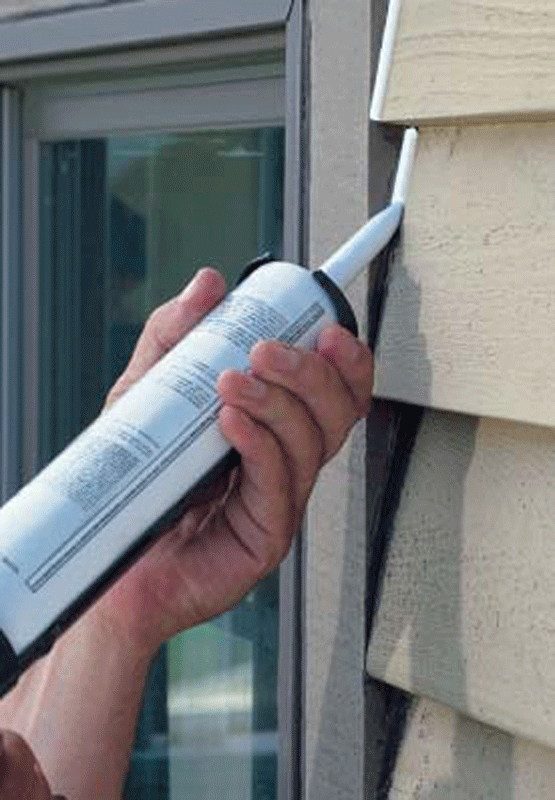Caulking
We are presently after redo this page for you, with more photos and more Important information,
We will be the reference!

Caulk is a flexible material used to seal air leaks through cracks, gaps, or joints less than 1-quarter-inch wide between stationary building components and materials. For components that move -- doors and operable windows, for example -- weatherstripping is the appropriate material.
Before caulking air leaks in an existing home, you will need to detect the leaks and assess your ventilation needs to ensure adequate indoor air quality. In addition to sealing air leaks, caulking can also prevent water damage inside and outside of the home when applied around faucets, ceiling fixtures, water pipes, drains, bathtubs, and other plumbing fixtures.
Warmed or air-conditioned air mixes with outside air through gaps in your homes thermal envelope exterior walls, windows, doors, the roof, and floors, Such air leaks can waste large amounts of energy.
Most experts agree that caulking and weather stripping any gaps will pay for itself within one year in energy savings. Caulking and weather stripping will also alleviate drafts and help your home feel warmer when its cold outside.
However, these two weatherization techniques cant replace the need for proper insulation throughout your home, *Remember that windows facing the sun for long periods will deteriorate the caulking much faster!
Detecting air leaks
You may already know where some air leakage occurs in your home, such as an under-the-door draft that makes you want to put on socks. But youll probably need to search to find the less obvious gaps.
Look at areas where different materials meet, like between brick and wood siding, between foundation and walls, and between the chimney and siding. Also inspect around the following for any cracks and gaps that could cause air leaks:
-Door and window frames
-Mail chutes
-Electrical and gas service entrances
-Cable TV and phone lines
-Outdoor water faucets
-Where dryer vents pass through walls
-Bricks, siding, stucco, and foundation
-Air conditioners
-Vents and fans.
Depressurize your home to help detect leaks
On a cool, very windy day, turn off the furnace. Shut all windows and doors. Turn on all fans that blow air outside, such as bathroom fans or stove vents. Then light an incense stick and pass it around the edges of common leak sites. Wherever the smoke is sucked out of or blown into the room, theres a draft.
Or just turn on all your exhaust fans (dont need to turn off the furnace) and try one of these methods:
At night, shine a flashlight over all potential gaps while a partner observes the house from outside. Large cracks will show up as rays of light. Not a good way to detect small cracks.
Shut a door or window on a piece of paper. If you can pull it out without tearing, youre losing energy.

COMMON AIR LEAKS

OUR COMPLETE CAULKING INSPECTION







Inspect condition of caulking around your doors and windows
Look at the examples below and compare them with your, No cracks, bubbles or loose caulking should be visible, The caulking must adhere to the frame of the window and exterior walls, also from the glass pane to the window frame (Sash).
If you see a resemblance to one of our examples, it's because,
The caulking is now at the end of its life and Must be redone before problems get worse.
Poor caulking can create this kind of problem
What is Caulking
The water will enter inside the walls and moisten the insulation and in a short time mold will appear as a black spot that will grow more and more every day to become a pink color and will generate additional costs.
At this point we must remove the part of the wall that is damaged inside the house as well as insulation, inspect the inside of the wall to remove any mold traces and rebuild a new wall, and that mean install new drywall, compound and sanding.
Do not wait, contact us now before it's too late, our estimates are free and without obligation on your part.
Breathe better, Sleep better and save energy with a caulking in excellent condition
The consequences!
If nothing is done in a short delay
Remember, never apply a new caulking over the old one because it will never stick and the new caulking will not give any protection and within a few months the work will have to start over again. Pay only once, have the work done by professionals.





Did you know!
that an excellent caulking can be flexible and stretch to over 900% of its size.
There is only one three-step process for replacing caulking, and only the experts know it!
Attention to inexperienced amateurs
These are your windows!
Your investment!
*Especially remember that*
What else can be caulk




















